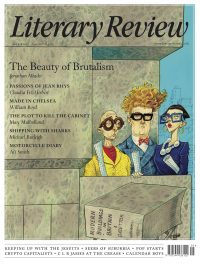Peter Parker
Hello, Boys
The Culture of Male Beauty in Britain: From the First Photographs to David Beckham
By Paul R Deslandes
University of Chicago Press 432pp £36
We now live in a world where the sexual objectification of men is catching up with that of women, though it might be argued that in the case of men this is largely self-imposed. Indeed, the fact that so many young men spend hours working out at gyms and posting the results of their self-enhancement on Facebook and Instagram suggests a kind of narcissism in which men turn the ‘male gaze’ upon themselves. By 2010, sales of grooming products for men in the UK were growing at twice the rate of those for women, but the notion that worrying about one’s appearance is no longer a feminine preserve and that even ‘real men’ need to think about their looks is of longer standing than one might imagine. The American historian Paul Deslandes has identified ‘a distinctively British culture of male beauty’ that stretches back two centuries, and he explores this in his wide-ranging and well-illustrated book.
Deslandes argues that male ‘beauty’ is a different quality from that of being ‘attractive’, ‘good-looking’ or ‘handsome’, and that the word is ‘reserved for particular exemplars like Rupert Brooke or, in the early twenty-first century, David Beckham and David Gandy’. As this suggests, notions of what constitutes male beauty have changed over the years. For example, the photographs of the men in the street thought by Honey magazine to represent ‘The Best in Britain’ in 1971 now look like mugshots of serial killers. Styles go in and out of fashion and even change meaning. The beard that was so much admired by the Victorians had more or less disappeared from the best faces by 1909, but has now made a return, while the short back and sides that ‘conveyed masculine conformity in the immediate postwar period’ became in the 1990s more associated with a ‘gay identity’. Body shapes also fall in and out of favour: at one moment we want our ideal men to be smooth-skinned and slender, at another we want them hirsute and muscled. All very confusing for the poor dears.
The book runs chronologically, beginning with a chapter on ‘Physiognomists and Photographers’ in the 19th century and ending with one entitled ‘Insecure Men, Metrosexuals, and Spornosexuals’ examining the past three decades. The study of human features in the belief that they can reveal aspects of a person’s character achieved

Sign Up to our newsletter
Receive free articles, highlights from the archive, news, details of prizes, and much more.@Lit_Review
Follow Literary Review on Twitter
Twitter Feed
In 1524, hundreds of thousands of peasants across Germany took up arms against their social superiors.
Peter Marshall investigates the causes and consequences of the German Peasants’ War, the largest uprising in Europe before the French Revolution.
Peter Marshall - Down with the Ox Tax!
Peter Marshall: Down with the Ox Tax! - Summer of Fire and Blood: The German Peasants’ War by Lyndal Roper
literaryreview.co.uk
The Soviet double agent Oleg Gordievsky, who died yesterday, reviewed many books on Russia & spying for our pages. As he lived under threat of assassination, books had to be sent to him under ever-changing pseudonyms. Here are a selection of his pieces:
Literary Review - For People Who Devour Books
Book reviews by Oleg Gordievsky
literaryreview.co.uk
The Soviet Union might seem the last place that the art duo Gilbert & George would achieve success. Yet as the communist regime collapsed, that’s precisely what happened.
@StephenSmithWDS wonders how two East End gadflies infiltrated the Eastern Bloc.
Stephen Smith - From Russia with Lucre
Stephen Smith: From Russia with Lucre - Gilbert & George and the Communists by James Birch
literaryreview.co.uk